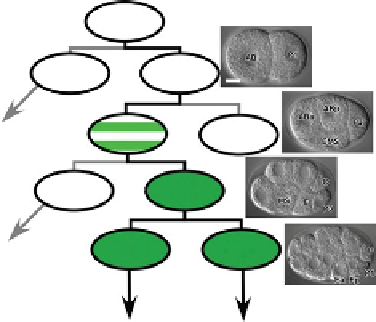Biology Reference
In-Depth Information
P0
(Zygote)
AB
P1
Pharynx (from ABa)
Rectum (from ABp)
EMS
P2
E
MS
Pharynx
Ea
Ep
Intestine
Figure 3.33
Early cell lineage of
C. elegans
.
Source
: From
Bossinger and Hoffmann, (2012)
.
leads to the production of the P2 and EMS (endoderm-mesoderm-stomodeum) cell
in the four-cell stage (
Bossinger and Hoffmann, 2012
).
The EMS blastomere contains a maternal
skn-
1 mRNA that is translated into the
transcription factor SKN-1. In turn, SKN-1 induces the expression of the
med-
1 and
med-
2 genes, which produce GATA-like transcription factors, necessary for the spec-
ification of the MS blastomere, but are less important for E blastomere specification.
Two other genes,
end-
1 and
end-
3, are also induced by SKN-1. They produce two
GATA factors, END-1 and END-3, which are primarily responsible for specifying
the E blastomere. The asymmetric division of the ESM results in the production of
the anterior MS blastomere and the posterior E blastomere. All 20 intestine cells and
38 of the pharynx cells of the worm derive from these two blastomeres (
Kormish
et al., 2010
). Intestine cells in
C. elegans
derive from a single cell, known as the E
blastomere, which present in the eight-cell embryo of the worm. One of the GATA
factors, ELT-2, regulates about 80% (
McGhee et al., 2009
) or possibly all (
Kormish
et al., 2010
) of the genes expressed in the
C. elegans
intestine during the late embry-
onic, larval, and adult stages.
Another epigenetic aspect of gastrointestinal development in vertebrates relates to
the enteric nervous system (ENS). The ENS forms from NCCs, which during early
development migrate primarily from the hindbrain and sacral regions of the neural
crest to colonize the presumptive gastrointestinal tract, where they differentiate into a
dozen neuron phenotypes and glia cells (
Figure 3.34
).
The role of the ENS in development and cell differentiation in the intestines is
demonstrated in denervation experiments. Denervation has a restraining influence
on enterocyte (
Vespúcio et al., 2008
) and goblet cell proliferation (
Hernandes et al.,
2003
) of gut epithelium. Chemical denervation may induce a hyperplasia of endo-
crine cells in enteric villi and crypts (
Santos et al., 2000
), and the loss of mucosal

Search WWH ::

Custom Search